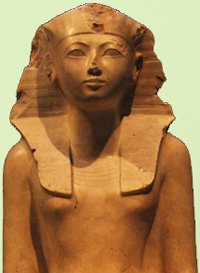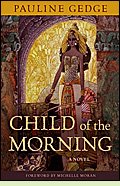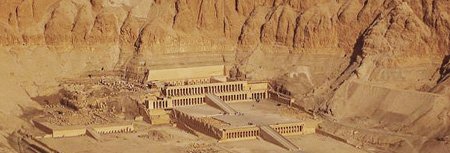|
Child of the Morningby Pauline GedgeReviewed by Margaret Donsbach Hatshepsut's victorious military campaigns at the beginning of her reign seem to have ushered in a period of peace, allowing her to restore trade networks disrupted several generations earlier when the Hyksos attacked, and to increase Egypt's wealth. She sent a successful expedition to the Land of Punt, which brought back live myrrh trees. She also built a magnificent temple complex at Deir el-Bahri, one of hundreds of construction projects she completed. Such a remarkable woman must have been remarkable from childhood. The novel portrays an intelligent, courageous and determined girl of memorable complexity. "She radiated the unconscious arrogance of royalty," blended with so much charm and compassion that it's easy to see how the affection of her courtiers and subjects could have strengthened her reign. Senmut, the gifted man of common birth who became her chief architect and rose to become her high steward and very likely her closest adviser, may also, some Egyptologists theorize, have been her lover. Gedge adopts this theory, making it the heart of her novel without turning it into historical romance, instead portraying a complicated but loving relationship in which Hatshepsut, above all, cultivates her power as pharaoh. Since Child of the Morning was first published, new archaeological and historical work has revealed information not available when Gedge wrote it. In particular, the conflicts between Hatshepsut and her successor may have been less serious than portrayed. Even so, it is hard to imagine a more vivid and believable portrayal of Hatshepsut's essential personality and her course to the throne. (1977; new Chicago Review Press edition 2010, 403 pages including a Foreword by Michelle Moran) More about Child of the Morning at Powell's Books or Amazon.com 
Other novels about Hatshepsut: Pharaoh by Eloise Jarvis McGraw (1958). More info Hatshepsut: Daughter of Amun by Moyra Caldecott (1989). More info King and Goddess by Judith Tarr (1996). More info
Hatshepsut: From Queen to Pharaoh by Catharine H. Roehrig (2005), lavishly illustrated with photographs of artifacts and archaeological sites. More info Hatchepsut: The Female Pharaoh by Joyce A. Tyldesley (1996), a biography. More info
Secrets of Egypt's Lost Queen
Back to Novels of Ancient History
|

